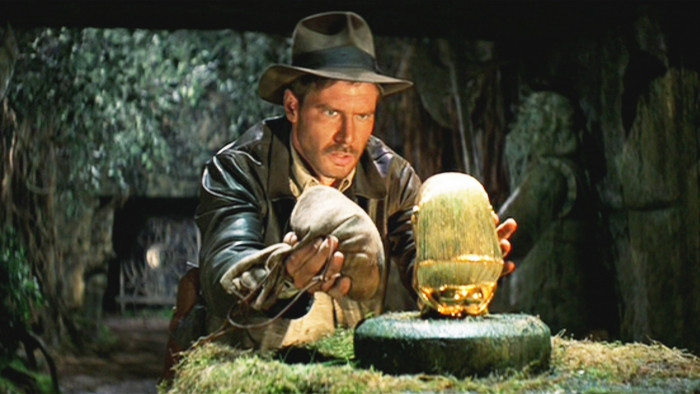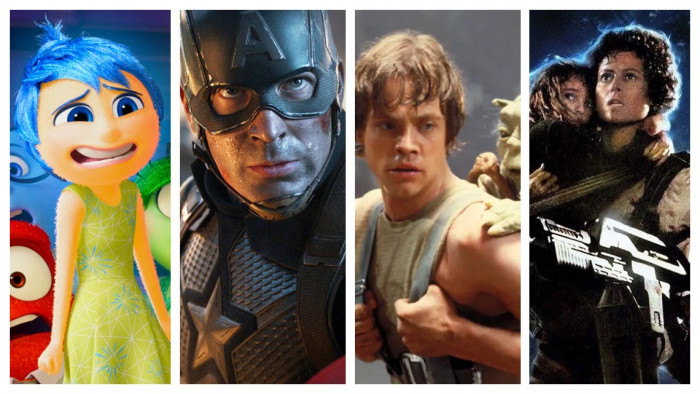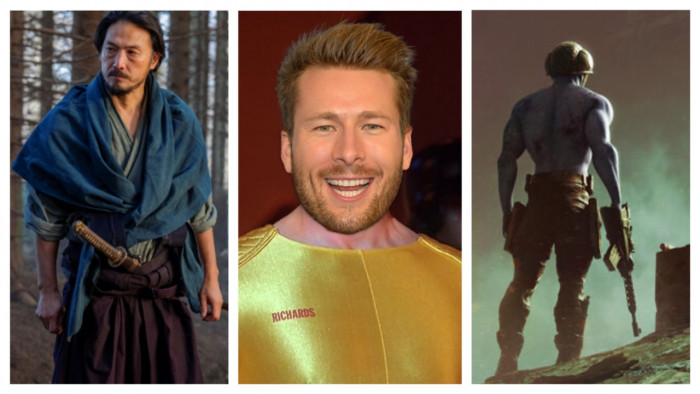The finest fright films understand how to create immersive, all-encompassing environments. They build cinematic landscapes that exploit and manipulate the science of sound and vision and subconsciously worm their way under your skin. Sure, some believe that an effective film starts with the script, and certainly it can. But horror is the exception. At its most potent, horror bypasses the intellect and heads right for the gut. You ultimately respond to horror viscerally, first, then your brain processes your reaction to it after the fact.
In 1954’s atomic ant chiller Them!, the squealing sound of the jumbo killer insects’ hunger scream is what sends shudders down spines, long before you see the wonky beasts themselves. The film creates a stunning feeling of dread with that aural cue alone, echoing across the sun-baked desert. Similarly, Robert Wise’s intense 1963 Shirley Jackson adaptation The Haunting traps its protagonists in an impossibly Gothic mansion, fetishising its environment before sending its cast – and the audience – into virtual paralysis with a non-stop barrage of smashing doors, banging walls and shaking timbers. And yet no monster is seen, no answers are had. Its genius is in its simplicity and masterful manipulation of the senses.
In Philip Kaufman’s 1978 version of Invasion Of The Body Snatchers, images of splitting pods birthing humanoid space infants are accompanied not only by composer Denny Zeitlin’s avant-garde score but also sound-effects sculptor Benjamin A Burtt’s use of a real fetal monitor throbbing on the soundtrack; the juxtaposition of a comforting, clinical sound with something evil and alien is uncanny.
That same year, director John Carpenter defined the parameters of the ‘slasher’ film with his landmark thriller Halloween, a movie that is minimalist in plot, dialogue and action yet packs a heavy punch, due in no small part to Carpenter’s use of sound and his own original synth score.
“My dad taught me about 5/4 time when I was 13,” Carpenter tells me. “I had a set of bongos and learned it on those. When it was time to score Halloween, I used that knowledge to sit down at a piano and do octaves – ding, ding, ding – and went up a half step and there it was, the theme was born. And all of my early films’ soundtracks – from Halloween to Dark Star, Assault On Precinct 13 to The Fog – were composed without image. They were simply recorded and then put into the movies at various points where I thought they worked best.”

Though music is the key element that envelopes Halloween, it’s also the way Carpenter and DP Dean Cundey use camera movement to both prowl the suburban streets and often just sit still and observe, voyeuristically. This is mixed with the occasional novel use of POV shots for the killer’s perspective, making the audience complicit and providing a sense of paranoia, a feeling that something, somewhere is always waiting, ready to strike.
In Ridley Scott’s 1979 sci-fi horror film Alien, legendary composer Jerry Goldsmith strips down his mesmerising, reverb- and percussion-heavy Planet Of The Apes score and creates a swirling ambient blanket of noise that is punctuated by the shock and horror of watching actors explode and get torn to bloody bits. Combining Michael Seymour’s production design, in which a set feels as if you’re trapped in a spaceship by way of a haunted house, Derek Vanlint’s strobing lighting schematics and HR Giger’s drooling, insectile monster, Alien’s sensory aesthetic has become iconic, one that has served it well over a seemingly unyielding and wildly varied franchise.
The latest entry in the Alien series is Scott’s Prometheus sequel Alien: Covenant, which despite updates in technology and differences in tone, seems to once more fetishise the unique-looking – and sounding – world built so beautifully in the first film.
In zombie-movie pioneer George A Romero’s 1978 masterpiece Dawn Of The Dead, the modestly budgeted action/horror film was brought to stirring life not only by Tom Savini’s revolutionary splatter FX, but also by Romero’s trademark use of exciting, bizarre and often humorous library cues from the existing De Wolfe Music catalogue. These brush up against a pummelling score by Italian progressive rock band Goblin, who had previously found fame using music and percussion to saturate Dario Argento’s masterful 1977 horror Suspiria.
“The deal was Dario Argento [who co-financed the film] would have the Italian rights to cut Dawn as he saw fit and I could use as much or as little of the Goblin music as I wanted in my US cut,” says Romero. “But outside of the Goblin material, I used tons of those great needle-drop music tracks and sound effects that had been used before, dozens of times, in old westerns and war films: gunshots, explosions, really great and loud stuff that made the movie seem bigger somehow. And the De Wolfe music just added some humour to the movie. Because, y’know, Dawn was always intended to be this big comic-book romp.”
Incidentally, Argento’s cut of Dawn Of The Dead (called ‘Zombi’) removes all of the De Wolfe material, robbing the picture of most of its absurdity, emotional impact and, frankly, personality. Savini’s grey-faced ghouls stumbling up the down escalators just aren’t the same without the strains of the needle-drop polka track The Gonk.

A stunning example of the indivisible nature of sound and image in horror is director Alan Parker’s 1987 neo-noir Angel Heart. In it, private eye Harry Angel (Mickey Rourke) investigates voodoo and murder in both Fifties New York and New Orleans, and the remarkable soundtrack by Trevor Jones creates the aural quicksand for both the character and the audience to get lost in. Sound editor Eddy Joseph mixes Jones’s drone-heavy music with Courtney Pine’s dissonant saxophone, repeating sounds and stock screams with echoes of old Bayou blues tracks to frighten and seduce.
Many horror films don’t necessarily marry sound and image in organic ways. In director Jonathan Glazer’s nightmarish 2013 science-fiction shocker Under The Skin, the images are stark and balance between vérité realism and abstract surrealism. The film sees Scarlett Johansson as a frequently nude alien wearing the skin of a dead human who rolls through the streets of Edinburgh luring horny men to her lair, where she harvests them for her planet. As this comely alien being walks through the ordinary world, Glazer uses the natural special-effect of Johansson’s idiosyncratic features to mesmerise the audience (much like he did with Nicole Kidman’s porcelain visage in 2004’s Birth), but also utilises strange sound effects, long takes and a completely discordant anti-musical score by British composer Mica Levi – her first film assignment, incidentally – hammering over his carefully controlled visuals to create something completely unsettling.
“I felt the project needed a fresh perspective and someone who hadn’t really been heard yet and who hadn’t attempted a movie score before,” says Glazer of his choice.
“The score is the lifeforce of the film, in a sense. It’s the interior of the character. It’s the foundation of the character. It’s the alien entity. It has a lot of roles to play. It lifts the film. It informs. It’s very compelling formally, but it’s also very clever in how fluid it is and how it’s part of the unity of all those ingredients. It’s a very powerful, unique score and I would still think that, were it not my film.”
In 2015, New York director Mickey Keating expertly used music, sound effects and visual aesthetics to mirror the psychological state of his homicidal heroine in his stylish and frightening primal scream of a horror film Darling. It stars Lauren Ashley Carter as the titular young woman who, while housesitting in an elegant Brownstone, proceeds to go stark raving mad, murdering anyone who has the misfortune of crossing her lethal path. Shot in silver-toned black and white, the film – which owes much to Roman Polanski’s cult 1965 chiller Repulsion – employs Kubrickian framing, long takes and smash-cut editing as well an experimental sound design and musical score to get us deep inside the troubled mind of Darling herself. Composer Giona Ostinelli uses percussion, strings and found sounds to hammer home key moments of dread and shock.

“Early on in the process, Mickey and I spoke at length about the sound of Darling,” says Ostinelli. “We discussed using the waterphone as one of the main instruments, so I went ahead and started experimenting by recording several of those and creating a variety of eerie textures. We also talked about portraying the classic and elegant side of Darling. That is where the idea of incorporating piano and strings came from, however I couldn’t just use a regular piano throughout, there had to be a twist. So later on in the picture, as Darling’s visions slowly become more maddening, the piano sound starts transforming and becomes reversed and distorted.”
Culturally, horror is often relegated to the dump bin, a ‘low’ genre, shallow, crass and designed for dummies. But that’s simply not the case. Horror films can be carefully orchestrated works of dark, primal art, direct links to our collective subconscious dread. The best ones employ all the liberal arts to create flickering dances of pursuit and retreat, of aggression and submission, of Freudian impulse demanding total surrender. It’s a genre forged in sound and fury and might actually be the most sophisticated of entertainments after all.

(Images: Rex/AllStar)
Latest
Related Reviews and Shortlists


The 10 best war movies of the 21st century









